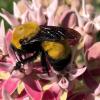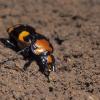
(Gastropoda: Haliotidae)
Petitioned by the Center for Biological Diversity, the white abalone (Haliotis sorenseni) is the first marine invertebrate to be listed under the U.S. Endangered Species Act; it was listed as endangered in June 2001. Its historic range extended from Point Conception, CA to Baja California, Mexico, but commercial and recreational harvesting nearly extirpated its populations. The state of California closed all abalone fisheries in 1997 to aid in the recovery of this species. However, due to low population densities, the white abalone has not been able to reproduce, and is on the brink of extinction.

The white abalone has a thin and light oval shell that is highly arched, with three to five open respiratory pores that are highly elevated above the shell’s surface. The inside of the abalone’s shell is pearly white and its muscle scar is poorly defined or lacking entirely (Cox 1962). Adult white abalone shells can be up to 25 cm long (NMFS 2006).
Halitois sorenseni (Bartsch 1940).
White abalone have a life expectancy of about thirty-five to forty-years, and reach sexual maturity around 4 to 6 years. They are dioecious, meaning that they have separate sexes (NMFS 2006). They have high fecundity and reproduce through ‘broadcast spawning’; millions of eggs or sperm are released during spawning events (Leighton 2000). In order to successfully reproduce, the male and female abalone must be close enough together – within a few meters (Davis et al. 1996). Commercial fishing pressures reduced its population densities so low that remaining individuals are too scattered to successfully reproduce. If reproductive ability declines with age, the species may already be functionally extinct. The last documented reproduction of this species was in 1966 (Cummings 2001).
White abalone are in their larval stage for 1 to 2 weeks, and can disperse up to 50 meters away from their parents (Prince et al. 1987, McShane et al. 1988). Larvae are lecithotrophic, meaning they swim freely, getting nutrition from their yolk sac (Leighton 2000, NMFS 2006). They choose a suitable substrate to settle in, and metamorphosis is triggered by a combination of chemical, physical and biological cues (Leighton 2000).
Once settled in a substrate, juvenile white abalone subsist on benthic diatoms, bacterial films, and other benthic microflora (NMFS 2006). Juveniles choose relativley sheltered substrates such as in rock crevices or underneath sea urchins; adults re-locate to more exposed habitats so they can access macroalgae (NMFS 2006). They gather food on rocky substrates with their radula and other mouth parts, and catch floating food with their foot, bringing it to their mouth to consume. Their tentacles detect the presence of food floating by.
In the 1970s, the white abalone was found in high densities in rocky reef habitats on the California coast at depths of 26 to 65 meters (Davis et al. 1996). Its historic range extended from Point Conception, CA to Baja California, Mexico. Recreational and commercial harvesting had a deleterious effect on this show-moving species. Fishermen deleted population after population of the species, moving from one to the next as they saught out unexploited populations. By the 1990s the species was nearly extirpated. Surveys conducted from 1992-3 at 15 known historic sites for this species found only three individuals (Davis et al. 1996). Remaining individual;s have a population density of about 1 per hectare, which is about one ten-thousandth of their previous density of one per square meter (Cummings 2001). Since adults must be within a few meters of each other to reproduce successfully, the species may already be functionally extinct. Approximately 1,600 individuals remain, and it is estimated that without intervention, the species will be extinct by 2010 (NMFS 2006).
The white abalone was listed as an endangered species throughout its range under the Endangered Species Act in June 2001 (NMFS 2006). It is the first marine invertebrate species to be listed under the Endangered Species Act. A draft Recovery Plan was completed in 2006.
The white abalone has a Global Heritage Status of G1 (Critically Imperiled), and a State Heritage Status for California of S1.
The main threats to the continued existence of the white abalone are related to the effects of critically low density on the reproductive ability of remaining individuals. Populations of white abalone have been drastically reduced and brought to the point of near extinction primarily by overutilization by commercial and recreational harvesters (NMFS 2006).
Other threats include inadequate enforcement of existing regulations, reduced genetic diversity and resulting lowered genetic fitness, the spread of disease through supplementation of populations, illegal harvesting, and habitat modification through human activity and climate change (NMFS 2006).
Conservation priorities included in the draft recovery plan (NMFS 2006) include:
1. Monitoring of populations and habitat to further understanding of remaining populations throughout the species’ range.
2. Protection of populations and their habitat by the establishment of Marine Protected Areas.
3. Captive propagation for enhancement of wild populations.
4. The development of a plan for public outreach and education to reduce illegal or accidental harvesting, and increased enforcement of regulations.
Cox, K. W. 1962. California abalones. Family Haliotidae. Calif. Dept. Fish. Game, Fish. Bull. 118: 1-133.
Cummings, B. 2001. White Abalone: The first marine invertebrate protected under the Endangered Species Act. Wings: Essays on Invertebrate Conservation. Fall 2001. The Xerces Society for Invertebrate Conservation, Portland, OR.
Davis, G. E., P. L. Haaker, D. V. Richards. 1996. Status and trends of white abalone at the California Channel Islands. Transactions of the American Fisheries Society 125(1):42-48.
Leighton, D.L. 2000. The Biology and Culture of the California Abalones. Dorrance Publishing Co., Inc., Pittsburgh, PA. 216 p.
McShane, P. E., Black, K. P., Smith, M. G. 1988. Recruitment processes in Haliotis rubra (Mollusca: Gastropoda) and regional hydrodynamics in southeastern Australia imply localized dispersal of larvae. Journal of Experimental Marine Biology and Ecology 124 (3), 175-203.
National Marine Fisheries Service. 2006. White Abalone Recovery Plan (Haliotis sorenseni), DRAFT. National Marine Fisheries Service, Long Beach, CA.
Prince, J. D., Sellers, T. L., Ford, W. B., Talbot, S. R. 1987. Experimental evidence for limited dispersal of haliotid larvae (genus Haliotis: Mollusca: Gastropoda). Journal of Experimental Marine Biology and Ecology 106 (3), 243-264.
Lisa Schonberg, The Xerces Society for Invertebrate Conservation





